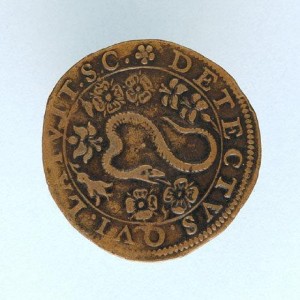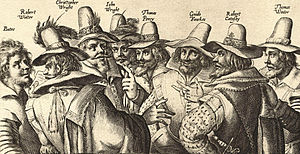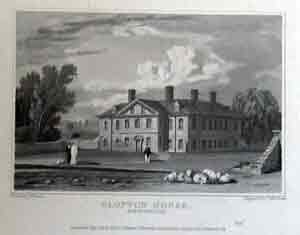 As I write this Guy Fawkes is trending on Twitter and “Occupy Wall Street” protestors are wearing Guy Fawkes masks inspired by the film Vendetta. Perhaps Guy Fawkes Day is set to become a politically meaningful date in the calendar instead of just an excuse to let off some fireworks around a bonfire.
As I write this Guy Fawkes is trending on Twitter and “Occupy Wall Street” protestors are wearing Guy Fawkes masks inspired by the film Vendetta. Perhaps Guy Fawkes Day is set to become a politically meaningful date in the calendar instead of just an excuse to let off some fireworks around a bonfire.
The Gunpowder Plot was an attempt to kill the king and members of his government and to destroy the Parliament building itself. Following James I’s accession in 1603 it had been hoped that he would adopt a more tolerant approach to Catholics, but this hope was quickly disappointed and powerful Catholics tried to find a way to return the country to Catholicism. Explosives expert Guy Fawkes was caught red-handed in a cellar beneath the Palace of Westminster with thirty-six barrels of gunpowder, just hours before the ceremonial opening of Parliament on 5 November 1605. It was later revealed that a tip-off had actually given the plot away days before.
Many of the conspirators had strong connections with the Warwickshire area and the effects of the unsuccessful plot were felt in Stratford-upon-Avon. Dr Robert Bearman’s new book Minutes and Accounts of the Stratford-upon-Avon Corporation 1599-1609 details the events that followed the plot.
In 1605 one of the less well-known conspirators, Ambrose Rookwood, leased Clopton House just outside Stratford to be nearer to the other plotters. Robert Catesby’s home was only 12 miles away and other key locations were nearby. Coughton Court, near Alcester, was a stronghold of the Catholic Throckmortons where the families of some of the plotters waited for news of its success or failure.
On the 6thNovember, just the day after Fawkes was arrested, news reached the area. Messengers must have ridden like the wind to travel the hundred or so miles from London so quickly. The town sheriff acted swiftly, searching Clopton House for evidence to link its
resident with the Catholic plot. The examination and valuation of the goods seized was carried out on 20 February the following year. The goods seized consisted of crucifixes, chalices, surplices and other evidence of Catholic worship. Most of the description is in Latin, with occasional phrases in English: “a Crosse of Copper with the picture of Christe uppon yt, and an Altar stone”, “a Little Silver Bell”, “a Vestemente of Crimson Satten with a pall and Armelettes belonging to the same”, “Five Latine Bookes”.
The accounts for 1605 include a number of payments indicating that the town swiftly moved to improve its defences. The payments in early November are for routine building maintenance, then: “Paid the vith of November to Richard Dewes for two pounds of gunpowder”. “Paid the same day for scouring of one musket, … four flaskes and one bandelyre to Henry Broome”, and “Paid the viith of November to Mrs Queeny for wyne that was brued for Mr Hailes when he came to survey the armour”. Later purchases included more gunpowder, bullets, swords and daggers .
At the Borough Sessions in January 1606 Catholic recusants “and suche as wee find that doe not come to Churche” were listed. Fourteen people are on the list, and Bearman notes that these investigations followed the discovery of the Gunpowder Plot a few months earlier, when all Catholics were seen as potentially suspicious.
These records show that the ripples of the Gunpowder Plot spread far and wide. In the Stratford area there was much jitteriness: It was rumoured that Fulke Greville’s house near Alcester had also been besieged. No wonder: the plotters fled through this area before the stand-off on the 8th November at Holbeache House in Staffordshire, where Robert Catesby was killed. Those who survived were executed in January 1606. Ambrose Rookwood was executed on the same day as conspirators Thomas Wintour and Guy Fawkes.
Interest in every aspect of the plot would have been intense and must have had an effect on Shakespeare. Although there’s no record of its first performance, Macbeth was almost certainly written and performed in 1606.
Shakespeare was too subtle and careful a man to write directly about contemporary events, but he took the basic story from his main sourcebook, Holinshed’s Chronicles and incorporated elements that would remind audiences of the Plot. The assassination of a reigning Scottish monarch, the flight of the suspected murderers, the Porter’s remarks about equivocation relating to the trial and execution of the Jesuit Father Garnet, the opening with its thunder and lightning, and the poetic consideration of regicide, evil and conscience made this a play much more than just a piece to flatter the new King.
 Until earlier this week (thank you, Globe Theatre) I’d never seen this jeton, or medal, which was struck after the event to commemorate the Plot. The image shows a snake surrounded by lilies and roses. Is it just a coincidence that Lady Macbeth tells her husband to “Look like the innocent flower, but be the serpent under it” or was this a direct reference to this medal? She continues:
Until earlier this week (thank you, Globe Theatre) I’d never seen this jeton, or medal, which was struck after the event to commemorate the Plot. The image shows a snake surrounded by lilies and roses. Is it just a coincidence that Lady Macbeth tells her husband to “Look like the innocent flower, but be the serpent under it” or was this a direct reference to this medal? She continues:
“You shall put
This night’s great business into my dispatch,
Which shall to all our nights and days to come
Give solely sovereign sway and masterdom”
The Gunpowder Plot was indeed a great business which had lasting repercussions, not least ensuring the centuries-long persecution and suspicion of Catholics throughout the country.
If you’re interested in acquiring a copy of Dr Bearman’s excellent book, please contact Cathy Millwood, at dugdale-society@hotmail.co.uk . Readers of this blog will be able to acquire it at the bargain rate of £30, a discount of £5 off the normal price.



